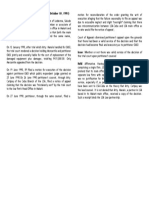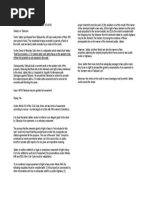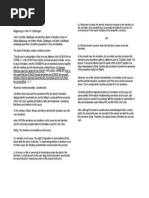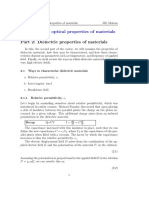0 ratings0% found this document useful (0 votes)
129 viewsNuclear Free Philippine Coalition, Et Al. vs. National Power Corporation
Nuclear Free Philippine Coalition, Et Al. vs. National Power Corporation
Uploaded by
001nooneThe document discusses a case regarding the proposed Nuclear Power Plant-1 (PNPP-1) in the Philippines. It finds that:
1) Petitioners question the competence of the commissioners reviewing the plant's safety. However, the court found competence is not a matter for judicial review unless an appointment is challenged.
2) Deficiencies in the application for an operating license, such as regarding funding and insurance, could potentially be remedied in further hearings.
3) There was evidence of bias, as pamphlets by the reviewing agency presumed the plant's safety without objective inquiry. The court ordered hearings to be reopened to allow petitioners to present evidence and cross-examine witnesses, and
Copyright:
© All Rights Reserved
Available Formats
Download as DOCX, PDF, TXT or read online from Scribd
Nuclear Free Philippine Coalition, Et Al. vs. National Power Corporation
Nuclear Free Philippine Coalition, Et Al. vs. National Power Corporation
Uploaded by
001noone0 ratings0% found this document useful (0 votes)
129 views2 pagesThe document discusses a case regarding the proposed Nuclear Power Plant-1 (PNPP-1) in the Philippines. It finds that:
1) Petitioners question the competence of the commissioners reviewing the plant's safety. However, the court found competence is not a matter for judicial review unless an appointment is challenged.
2) Deficiencies in the application for an operating license, such as regarding funding and insurance, could potentially be remedied in further hearings.
3) There was evidence of bias, as pamphlets by the reviewing agency presumed the plant's safety without objective inquiry. The court ordered hearings to be reopened to allow petitioners to present evidence and cross-examine witnesses, and
Original Description:
ENVIRONMENTAL LAW
Original Title
envi
Copyright
© © All Rights Reserved
Available Formats
DOCX, PDF, TXT or read online from Scribd
Share this document
Did you find this document useful?
Is this content inappropriate?
The document discusses a case regarding the proposed Nuclear Power Plant-1 (PNPP-1) in the Philippines. It finds that:
1) Petitioners question the competence of the commissioners reviewing the plant's safety. However, the court found competence is not a matter for judicial review unless an appointment is challenged.
2) Deficiencies in the application for an operating license, such as regarding funding and insurance, could potentially be remedied in further hearings.
3) There was evidence of bias, as pamphlets by the reviewing agency presumed the plant's safety without objective inquiry. The court ordered hearings to be reopened to allow petitioners to present evidence and cross-examine witnesses, and
Copyright:
© All Rights Reserved
Available Formats
Download as DOCX, PDF, TXT or read online from Scribd
Download as docx, pdf, or txt
0 ratings0% found this document useful (0 votes)
129 views2 pagesNuclear Free Philippine Coalition, Et Al. vs. National Power Corporation
Nuclear Free Philippine Coalition, Et Al. vs. National Power Corporation
Uploaded by
001nooneThe document discusses a case regarding the proposed Nuclear Power Plant-1 (PNPP-1) in the Philippines. It finds that:
1) Petitioners question the competence of the commissioners reviewing the plant's safety. However, the court found competence is not a matter for judicial review unless an appointment is challenged.
2) Deficiencies in the application for an operating license, such as regarding funding and insurance, could potentially be remedied in further hearings.
3) There was evidence of bias, as pamphlets by the reviewing agency presumed the plant's safety without objective inquiry. The court ordered hearings to be reopened to allow petitioners to present evidence and cross-examine witnesses, and
Copyright:
© All Rights Reserved
Available Formats
Download as DOCX, PDF, TXT or read online from Scribd
Download as docx, pdf, or txt
You are on page 1of 2
NUCLEAR FREE PHILIPPINE COALITION, ET AL. vs.
to result in lower occupational and public risks than fossil
NATIONAL POWER CORPORATION fired (coal or oil) stations.
The second pamphlet (Exh. "KK") is entitled "NUCLEAR
POWER-SAFE CLEAN ECONOMICAL AND AVAILABLE." On
(1) Petitioners question the competence of respondent
the surface, it merely propagates the use of nuclear power
PAEC (Philippine Atomic Energy Commission)
in general. But its numerous specific references to the
Commissioners to pass judgment on the safety of the
PNPP-1 "which will be operational in 1985." and its
Nuclear Power Plant-1 PNPP-1. (2) Also, petitioners assail
advantages give credence to the charge that Exhibit "KK"
the validity of the motion (application) filed by the National
was in reality designed to project PNPP-1 as safe, among
Power Corporation (NPC) for the conversion of its
other
construction permit into an operating license for PNPP-1
on the principal ground that it contained no information When Exhibit "KK" was published, PNPP-1 was the only
regarding the financial qualifications of NPC, its source of nuclear plant under construction in the Philippines. It is the
nuclear fuel, and insurance coverage for nuclear damage. Philippine nuclear plant specifically mentioned therein that
(3) There was bias and prejudgment. was to be operational in 1985. Therefore, when the
pamphlet states that nuclear power is working now in
1. The first issue must be resolved against the
other countries and "it should work for us too" because it
petitioners. Where the validity of an appointment is not
is "safe" and economical", it is logical to conclude that the
challenged in an appropriate proceeding, the question of
reference is to no other than the nuclear power to be
competence is not within the field of judicial inquiry. If not
generated at the PNPP-1
considered a qualification the absence of which would
vitiate the appointment, competence is a matter of Also worth quoting is the following passage in Exhibit "KK"
judgment that is addressed solely to the appointing power. which sweepingly vouch safes all nuclear power plants,
including the PNPP-1:
2. Petitioners contend that the deficiencies they have
indicated are jurisdictional infirmities which cannot be No member of the public has ever been injured during the
cured. The Court believes however that said deficiencies last 25 years that commercial nuclear reactors have been
may be remedied and supplied in the course of the hearing generating electricity. As is to be expected in any complex
before PAEC. For this purpose, respondent-applicant NPC system as nuclear power plants, there have been failure of
may submit pertinent testimonies and documents when equipment and human errors. However in every instance,
the PAEC hearing is re-opened, subject to controversion the safety equipment designed into the nuclear reactor self
and counterproof of herein petitioners. terminated the accident without injury to the operators or
the public. The Three Mile Island Incident, serious as it was,
3. There is merit in the charge of bias and
did not result in the loss of life nor did it result in the
prejudgment. The PAEC pamphlets- particularly Annexes
exposure of anyone beyond permissible limits.
"JJ", "KK" and "LL" of the petition (G.R. 70632)-clearly
indicate the pre-judgment that PNPP-1 is safe. The designers of nuclear plants assume failure to occur,
and provide multiple safeguards protection against every
Exhibit "JJ" is an official PAEC 1985 pamphlet entitled
conceivable malfunction
"PNPP-l." It gives an overview specifically of PNPP-1, lauds
the safety of nuclear power, and concludes with a The third pamphlet (Exh. "LL") is entitled NUCLEAR POWER
statement of the benefits to be derived when the PNPP-1 PLANT and ENVIRONMENTAL SAFETY. Speaking specifically
start operation. of the PNPP-1 it categorically states that the Bataan
nuclear plant will not adversely affect the public or the
. . .When the PNPP-1 starts operating, it will generate a
flora or fauna in the area. One of the stated reasons in
power of 620 megawatts enough to supply 15 percent of
support of the conclusion is that it does not cause chemical
the electricity needs in Luzon. This is estimated to result in
pollution of air or water, it does not emit sulfur dioxide or
savings of US $ 160 million a year, representing the amount
nitrogen oxides like plants fired by fossil fuels such as coal
of oil displaced.
and oil, Besides, even coal fired plants may emits
Aside from being a reliable source of electricity, nuclear radioactive particles of uranium and thorium because
power has an excellect safety record and has been found these may be found naturally associated with coal
deposits.
Comparatively therefore, a nucelar power plant is the correct or supply deficiencies in this application or
cleanest and the safest environmently no other technology evidence in support thereof.
in modern times has been developed with so dominant
concern for public safety as nuclear power.
Even if it be assumed that there are some doubts regarding
the conclusion that there has been a prejudgment of the
safety of PNPP-1 the doubts should be resolved in favor of
a course of action that will assure an unquestionably
objective inquiry, considering the circumstances thereof
and the number of people vitally interested therein.
Having thus prejudged the safety of the PNPP-1
respondent PAEC Commissioners would be acting with
grave abuse of discretion amounting to lack of jurisdiction
were they to sit in judgment upon the safety of the plant,
absent the requisite objectivity that must characterize such
an important inquiry.
The Court therefore Resolved to RESTRAIN respondent
PAEC Commissioners from further acting in PAEC Licensing
Proceedings No. 1-77.
In G.R. No. 68474, the urgent motion for mandatory
injunction and/or restraining order, the second urgent
motion for mandatory injunction dated August 12, 1985,
and the various pleadings and other documents submitted
by the parties relative thereto, and considering the
paramount need of a reasonable assurance that the
operation of PNPP-1 will not pose an undue risk to the
health and safety of the people, which dictates that the
conduct of the inquiry into the safety aspects of PNPP-1 be
characterized by sufficient latitude, the better to achieve
the end in view, unfettered by technical rules of evidence
(Republic Act 5207, section 34), and in keeping with the
requirements of due process in administrative
proceedings, the Court Resolved to ORDER respondent
PAEC (once reconstituted) to re-open the hearing on PNPP-
1 so as to give petitioners sufficient time to complete their
cross-examination of the expert witnesses on quality
assurance, to cross-examine the witnesses that petitioners
have failed to cross-examine on and after August 9, 1985,
and to complete the presentation of their evidence, for
which purpose, respondent PAEC shall issue the necessary
subpoena and subpoena duces tecum to compel the
attendance of relevant witnesses and/or the production of
relevant documents. For the said purposes, the PAEC may
prescribe a time schedule which shall reasonably assure
the parties sufficient latitude to adequately present their
case consistently with the requirements of dispatch. lt is
understood that the PAEC may give NPC the opportunity to
You might also like
- Manila Prince Hotel, Petitioner V Gsis, Respondent (DIGEST)Document3 pagesManila Prince Hotel, Petitioner V Gsis, Respondent (DIGEST)001nooneNo ratings yet
- 10 Alsua-Betts v. CADocument3 pages10 Alsua-Betts v. CAALIYAH MARIE ROJONo ratings yet
- G.R. No. 137174. July 10, 2000.Document16 pagesG.R. No. 137174. July 10, 2000.Xsche XscheNo ratings yet
- Environmental Law TSNDocument63 pagesEnvironmental Law TSNCiena MaeNo ratings yet
- Vda. de Gil v. Vda. de Murciano, G.R. No. L-3362, (March 1, 1951), 88 PHIL 260-287)Document20 pagesVda. de Gil v. Vda. de Murciano, G.R. No. L-3362, (March 1, 1951), 88 PHIL 260-287)yasuren2No ratings yet
- Del Rosario-Igtiben V RepublicDocument1 pageDel Rosario-Igtiben V RepublicGel TolentinoNo ratings yet
- MJ 2017 Barnotes PubcorDocument17 pagesMJ 2017 Barnotes PubcorMichael Ang SauzaNo ratings yet
- SPECPRO-Jerez Vs NietesDocument8 pagesSPECPRO-Jerez Vs NietesMark John Geronimo BautistaNo ratings yet
- 2) Local GovernmentDocument18 pages2) Local GovernmentPablo EschovalNo ratings yet
- Villacorta Vs Bernardo 143 Scra 480Document3 pagesVillacorta Vs Bernardo 143 Scra 480Kimberly Sendin100% (1)
- Notes in Succession By: Charisse Louie L. AmoscoDocument3 pagesNotes in Succession By: Charisse Louie L. AmoscoCharisse Louie AmoscoNo ratings yet
- General PrinciplesDocument15 pagesGeneral PrinciplesArt Anthony VillarinoNo ratings yet
- Special Proceedings Part II - Syllabus: CasesDocument3 pagesSpecial Proceedings Part II - Syllabus: CasesLiezl Oreilly VillanuevaNo ratings yet
- Commercial Law 2 (Notes and Briefs)Document13 pagesCommercial Law 2 (Notes and Briefs)criskot21No ratings yet
- Romero v. VillamorDocument1 pageRomero v. Villamorviva_33No ratings yet
- PIL Notes... PartialDocument3 pagesPIL Notes... PartialDon Carlos BinamiraNo ratings yet
- Review Notes in Corporation Law 2023Document13 pagesReview Notes in Corporation Law 2023Se'f BenitezNo ratings yet
- SpecPro Notes ComaDocument61 pagesSpecPro Notes ComaEdrich John LabradorNo ratings yet
- Case Digest: Lino Vs PanoDocument1 pageCase Digest: Lino Vs PanoYeshua TuraNo ratings yet
- The Water Code of The PhilippinesDocument6 pagesThe Water Code of The PhilippinesJamaica NolealNo ratings yet
- Tony LA VinaDocument10 pagesTony LA VinaBenjamin HaysNo ratings yet
- Heirs of Fausta Dimaculangan Vs Intermediate Appellate Court (IAC)Document4 pagesHeirs of Fausta Dimaculangan Vs Intermediate Appellate Court (IAC)rodel talabaNo ratings yet
- Public Officers Law - de Leon Reviewer - 1Document64 pagesPublic Officers Law - de Leon Reviewer - 1Megan ManahanNo ratings yet
- Forests - Modes of Utilizing Forests Resources, Qualifications For Utilization of Forests Resources, Forest Protection and Prohibited ActsDocument7 pagesForests - Modes of Utilizing Forests Resources, Qualifications For Utilization of Forests Resources, Forest Protection and Prohibited ActsNullus cumunisNo ratings yet
- RCBC VS Hi Tri Development CorporationDocument3 pagesRCBC VS Hi Tri Development Corporationjo123No ratings yet
- Succession Article 838 DigestsDocument11 pagesSuccession Article 838 DigestsenzomanzaneroNo ratings yet
- SpecPro Rules 92-95Document28 pagesSpecPro Rules 92-95BananaNo ratings yet
- Florentino Vs Florentino DigestDocument3 pagesFlorentino Vs Florentino DigestGlenda May PereiraNo ratings yet
- Torts and Damages PDFDocument54 pagesTorts and Damages PDFAngeli Pauline JimenezNo ratings yet
- Credit Transactions NotesDocument15 pagesCredit Transactions NotesLorenzo Angelo Acmor OcampoNo ratings yet
- 5) Palmares vs. Court of AppealsDocument24 pages5) Palmares vs. Court of AppealsresjudicataNo ratings yet
- 10 Hernaez v. Hernaez FullDocument6 pages10 Hernaez v. Hernaez FullJaysieMicabaloNo ratings yet
- Summary of Agcaoili Book 2016Document22 pagesSummary of Agcaoili Book 2016LwkxnNo ratings yet
- Rep. Vs Mendoza DigestDocument6 pagesRep. Vs Mendoza DigestXyrus BucaoNo ratings yet
- Arrogante vs. DeliarteDocument11 pagesArrogante vs. DeliarteyanieggNo ratings yet
- Alfredo Pacis and Cleopatra Pacis Vs Jerome Jovanne MoralesDocument4 pagesAlfredo Pacis and Cleopatra Pacis Vs Jerome Jovanne Moralescarlo_tabangcuraNo ratings yet
- De Gala Vs Gonzales L-30289Document4 pagesDe Gala Vs Gonzales L-30289norzeNo ratings yet
- City of Manila vs. IACDocument7 pagesCity of Manila vs. IACAJ AslaronaNo ratings yet
- Academic Discipline DigestDocument7 pagesAcademic Discipline DigestBing BongoNo ratings yet
- Heirs of Oscar Reyes V ReyesDocument1 pageHeirs of Oscar Reyes V ReyesOlek Dela CruzNo ratings yet
- LTD List of Common CasesDocument12 pagesLTD List of Common CasesAina ReyesNo ratings yet
- Commonwealth Act 141Document4 pagesCommonwealth Act 141Pagsesq PantaleonNo ratings yet
- 26 Guerrero vs. Bihis (Art 806)Document1 page26 Guerrero vs. Bihis (Art 806)Joshua Erik MadriaNo ratings yet
- Collation (Arellano v. Pascual)Document1 pageCollation (Arellano v. Pascual)apperdapperNo ratings yet
- Seville v. National Development CompanyDocument5 pagesSeville v. National Development CompanySheena Reyes-BellenNo ratings yet
- Crisologo Vs SingsonDocument3 pagesCrisologo Vs Singsonteryo expressNo ratings yet
- Ilao-Oreta v. Sps Ronquillo /ESCRADocument14 pagesIlao-Oreta v. Sps Ronquillo /ESCRAMaria Francheska GarciaNo ratings yet
- Baterina Vs ComelecDocument1 pageBaterina Vs ComelecxyrakrezelNo ratings yet
- Alvarez V. Iac G.R. No. L-68053 May 7, 1990 FactsDocument2 pagesAlvarez V. Iac G.R. No. L-68053 May 7, 1990 FactsMichaelNo ratings yet
- Patalinghug Vs CADocument2 pagesPatalinghug Vs CAMarilyn Padua AnnangNo ratings yet
- Ouano Vs Ca Case DigestDocument1 pageOuano Vs Ca Case DigestNadine Reyna CantosNo ratings yet
- Sux Digest Arts 818-838 (Incomplete)Document29 pagesSux Digest Arts 818-838 (Incomplete)Praisah Marjorey Casila-Forrosuelo PicotNo ratings yet
- 2nd Exam Consti TSN GarciaDocument70 pages2nd Exam Consti TSN GarciaPauline Kay RojoNo ratings yet
- Cruz Vs Denr Separate OpinionsDocument7 pagesCruz Vs Denr Separate OpinionsCzarina AureNo ratings yet
- NAT RES Outline 1Document26 pagesNAT RES Outline 1nildin danaNo ratings yet
- Advent Capital and Finance Corp. v. AlcantaraDocument5 pagesAdvent Capital and Finance Corp. v. AlcantaraMayumi RellitaNo ratings yet
- PLS Succession Midterm Exam QuestionsDocument7 pagesPLS Succession Midterm Exam QuestionsOdsNo ratings yet
- Written DigestsDocument3 pagesWritten DigestsMaria Angelica LucesNo ratings yet
- Tanada V PAECDocument2 pagesTanada V PAECM A J esty FalconNo ratings yet
- Tanada Vs PaecDocument2 pagesTanada Vs PaecAnonymous geq9k8oQyONo ratings yet
- Nuclear Electric Power: Safety, Operation, and Control AspectsFrom EverandNuclear Electric Power: Safety, Operation, and Control AspectsNo ratings yet
- REPUBLIC Vs TAMPUS TO KALAW Vs FERNANDEZDocument5 pagesREPUBLIC Vs TAMPUS TO KALAW Vs FERNANDEZ001nooneNo ratings yet
- 2nd Case AssignmentDocument26 pages2nd Case Assignment001nooneNo ratings yet
- Accounting Profit Vs Taxable ProfitDocument2 pagesAccounting Profit Vs Taxable Profit001nooneNo ratings yet
- Airborne Maintenance and Allied Services20190606-6342-JbcziqDocument7 pagesAirborne Maintenance and Allied Services20190606-6342-Jbcziq001nooneNo ratings yet
- Roman Catholic VS RamosDocument8 pagesRoman Catholic VS Ramos001nooneNo ratings yet
- Plaintiff-Appellee Vs Vs Defendant-Appellant Basilio Aromin Acting Attorney-General ZaragozaDocument5 pagesPlaintiff-Appellee Vs Vs Defendant-Appellant Basilio Aromin Acting Attorney-General Zaragoza001nooneNo ratings yet
- 749-Unchuan Vs LozadaDocument1 page749-Unchuan Vs Lozada001nooneNo ratings yet
- 3rd Cases-Labor-Ft PDFDocument42 pages3rd Cases-Labor-Ft PDF001nooneNo ratings yet
- Lindain Vs CADocument1 pageLindain Vs CA001nooneNo ratings yet
- Plaintiff-Appellee Vs Vs Defendants-Appellants Thomas L. Mcgirr, Attorney-General AranetaDocument2 pagesPlaintiff-Appellee Vs Vs Defendants-Appellants Thomas L. Mcgirr, Attorney-General Araneta001nooneNo ratings yet
- Plaintiff-Appellee Vs Vs Defendant-Appellant Garner & Denison, Solicitor-General AranetaDocument2 pagesPlaintiff-Appellee Vs Vs Defendant-Appellant Garner & Denison, Solicitor-General Araneta001nooneNo ratings yet
- Guevarra Vs AlmodovarDocument3 pagesGuevarra Vs Almodovar001nooneNo ratings yet
- Complainant-Appellee Vs Vs Defendant-Appellant Felix Ferrer, Solicitor-General AranetaDocument2 pagesComplainant-Appellee Vs Vs Defendant-Appellant Felix Ferrer, Solicitor-General Araneta001nooneNo ratings yet
- System of Government Under 1987 ConstitutionDocument3 pagesSystem of Government Under 1987 Constitution001nooneNo ratings yet
- 619-Valdez Vs TabisulaDocument1 page619-Valdez Vs Tabisula001nooneNo ratings yet
- Article 614 - Liwag Vs Happy Glen LoopDocument3 pagesArticle 614 - Liwag Vs Happy Glen Loop001nooneNo ratings yet
- Gonzales Vs de DiosDocument1 pageGonzales Vs de Dios001nooneNo ratings yet
- Unisource V. Chung FactsDocument1 pageUnisource V. Chung Facts001nooneNo ratings yet
- 729-Maglasang Vs Heirs of CabatinganDocument1 page729-Maglasang Vs Heirs of Cabatingan001nooneNo ratings yet
- Sta Rosa Realty Devpt Co VS CaDocument6 pagesSta Rosa Realty Devpt Co VS Ca001nooneNo ratings yet
- Javellana vs. The Executive Secretary 50 SCRA 30Document11 pagesJavellana vs. The Executive Secretary 50 SCRA 30001nooneNo ratings yet
- Masaganang Ani Program. This Amount Was Used ToDocument8 pagesMasaganang Ani Program. This Amount Was Used To001nooneNo ratings yet
- Rule 98 and 91-Case DigestDocument12 pagesRule 98 and 91-Case Digest001nooneNo ratings yet
- Writ of Habeas Data - # 4Document1 pageWrit of Habeas Data - # 4001nooneNo ratings yet
- Nova EclipseDocument6 pagesNova Eclipseluis840zeroNo ratings yet
- Flight No. Frequency Depart Time/Terminal Arrival Time/Terminal Operated by See NotesDocument2 pagesFlight No. Frequency Depart Time/Terminal Arrival Time/Terminal Operated by See NotesJohn Paul M. MoradoNo ratings yet
- Chapter I Group 1 11-Stem CDocument2 pagesChapter I Group 1 11-Stem CMark DesearNo ratings yet
- YogaDocument4 pagesYogaAmbar PurohitNo ratings yet
- Infectious DiseasesDocument144 pagesInfectious DiseasesMd.Mahmudul HasanNo ratings yet
- Tumcos Consumer CaseDocument8 pagesTumcos Consumer CasesanjaytrustlawNo ratings yet
- Diploma in EcotourismDocument16 pagesDiploma in Ecotourismleo leoNo ratings yet
- Ezzeldin 2016Document13 pagesEzzeldin 2016William AvilaNo ratings yet
- Diwat National High School (DNHS) Animal Production (Swine) NC Ii Progress ChartDocument1 pageDiwat National High School (DNHS) Animal Production (Swine) NC Ii Progress ChartKirsten Q. CaminongNo ratings yet
- NFPA 505-A2002 - Fire Safety Standard For Powered Industrial Trucks Including TypeDocument12 pagesNFPA 505-A2002 - Fire Safety Standard For Powered Industrial Trucks Including TypeMursid SispamuntraNo ratings yet
- Collier v. McKayDocument22 pagesCollier v. McKayTHRNo ratings yet
- CV DipankarDocument29 pagesCV DipankarAYAN713148No ratings yet
- What Is A TextDocument17 pagesWhat Is A TextFebri SusantiNo ratings yet
- Host PreviewDocument219 pagesHost PreviewJakeNo ratings yet
- Solutions To Class Problems - Portfolio TheoryDocument7 pagesSolutions To Class Problems - Portfolio TheoryVivek MandalNo ratings yet
- Interactive Technology Magazine TemplateDocument16 pagesInteractive Technology Magazine TemplateKanishk SinghNo ratings yet
- Ramdump Modem 2023-09-07 07-20-23 PropsDocument26 pagesRamdump Modem 2023-09-07 07-20-23 PropsIván Carrera YentzenNo ratings yet
- Unit 4 - Session 6Document33 pagesUnit 4 - Session 6Mahek Agarwal (RA1911003010893)No ratings yet
- Civil Procedure Code 1908: SearchDocument3 pagesCivil Procedure Code 1908: SearchshaannivasNo ratings yet
- Electrical and Optical Properties of MaterialsDocument18 pagesElectrical and Optical Properties of MaterialsRoy VeseyNo ratings yet
- 2013-11-02 MackenzieDocument1 page2013-11-02 MackenzieGrace LarsonNo ratings yet
- Deactivation - Reactivation of SBC Self TestDocument3 pagesDeactivation - Reactivation of SBC Self TestxnsxmannyNo ratings yet
- Non Fiction Penguin Abc FormDocument3 pagesNon Fiction Penguin Abc Formapi-610940178No ratings yet
- Computer As Tool, Tutor and TuteeDocument2 pagesComputer As Tool, Tutor and TuteeFatihah Abd RahmanNo ratings yet
- 2019 DYNAmore Seminarbrochure e PDFDocument64 pages2019 DYNAmore Seminarbrochure e PDFklausoshoNo ratings yet
- Chapter IDocument7 pagesChapter IKarlisNo ratings yet
- Hagedorn 2023 Bim Enabled Infrastructure Asset MaDocument17 pagesHagedorn 2023 Bim Enabled Infrastructure Asset MaCarlos Andres Rua MachadoNo ratings yet
- EM MultiV5 LGRED OutdoorUnits PDFDocument95 pagesEM MultiV5 LGRED OutdoorUnits PDFenlightened1718No ratings yet
- Lesson 1: MNS 1052 3-chiều thư năm. Cô Trinh. Team Code: t11m5ze doanvx@isvnu.vnDocument47 pagesLesson 1: MNS 1052 3-chiều thư năm. Cô Trinh. Team Code: t11m5ze doanvx@isvnu.vnHong NguyenNo ratings yet
- New Phytologist - 2010 - OllingerDocument20 pagesNew Phytologist - 2010 - OllingerDébora PlácidoNo ratings yet


















































































































